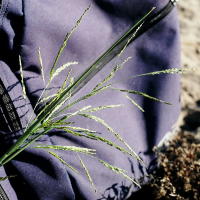Fall panicum
Panicum dichotomiflorum
Panicum dichotomiflorum, commonly known as fall panicum or panic grass, is a species of grass that belongs to the Poaceae family. It is native to North America and is considered an annual or short-lived perennial grass. Fall panicum is found in a variety of habitats, including fields, disturbed areas, and roadsides. Here is some information about Panicum dichotomiflorum:
Appearance:
- Fall panicum is a tufted grass with an erect or ascending growth habit.
- The stems can vary in height but generally reach 30 to 100 centimeters (12 to 40 inches).
- The leaves are linear, flat, and can be either hairless or have short hairs along the margins.
- The inflorescence consists of small spikelets arranged in open panicles. Spikelets have two florets.
Habitat:
- Fall panicum is adaptable to various environments and can be found in disturbed areas, cultivated fields, meadows, and along roadsides.
- It is considered a weed in some agricultural settings.
Lifecycle:
- Fall panicum is an annual or short-lived perennial grass.
- It reproduces by seed. The seeds are produced in the spikelets of the inflorescence.
Ecological Impact:
- Fall panicum is considered invasive in some regions and can compete with and displace native vegetation.
- As a weed, it may negatively impact agricultural crops.
Cultural Uses:
- While fall panicum is not cultivated for specific uses, it is a common grass species encountered in various landscapes.
Identification:
- The identification of fall panicum can be based on characteristics such as the arrangement of spikelets, the presence or absence of hairs on leaves, and the growth habit.
Panicum dichotomiflorum serves as an example of a grass species with ecological adaptability, and its presence is notable in a range of environments, particularly in disturbed or cultivated areas. However, it is important to manage its growth in agricultural settings to prevent it from becoming a weed that competes with crops.















